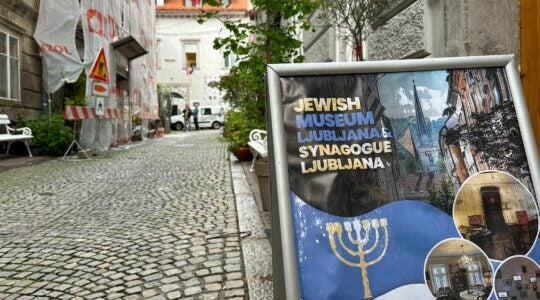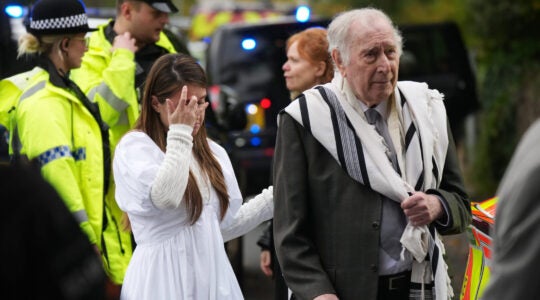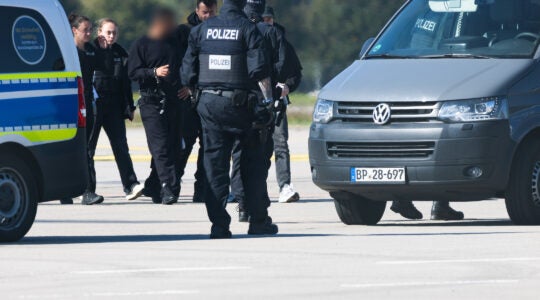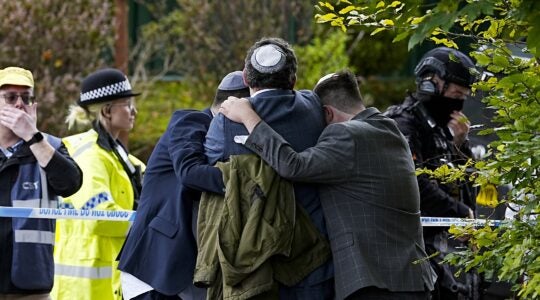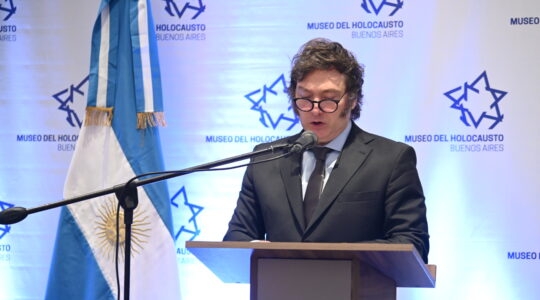
The “big stone” monument in Treblinka commemorating the thousand of Jews who were murdered at the Treblinka death camp, with the inscription “Never Again” written in six languages. (Photo by euroIL via CC)

Caroline Sturdy Colls, right, with a reporter for the BBC at the site of Treblinka, where she has found signs of previously missing mass grave sites. (Courtesy Caroline Sturdy Colls)
(JTA) — Scientists using ground-probing electronics may have discovered the missing mass graves at the site of Treblinka, one of the Nazis’ most notorious death camps.
No actual bodies were found and the graves were not excavated, in keeping with Jewish law, but bones and bone fragments were discovered in the ground, according to Caroline Sturdy Colls, a forensic archeologist at Straffordshire University in Britain who headed the research.
The underground structures detected by her equipment outlines what most likely are the graves.
Historians believe as many as 850,000 people, mostly Jews and some Roma, or Gypsies, died at Treblinka.
Although eyewitnesses told of the existence of mass graves, the Germans did everything they could to cover up their crimes, and the inability of researchers to find them was sometimes used by Holocaust deniers to claim large-scale murder did not occur at Treblinka.
Sturdy Colls used aerial photographs from the 1940s, satellite imagery, GPS mapping devices and new ground-penetrating radar. The radar could not detect corpses but could detect differences between the ground and disturbances and inconsistencies in the ground, such as buried objects, in 11 areas.
“Given their size and location, there is a strong case for arguing that they represent burial areas,” she said.
Sturdy Colls began working at Treblinka in 2010. She and her colleagues used radar and electrical imaging to get an idea of what was underground without actually disturbing the site. One of the first things she discovered was that the early maps of the site were incorrect — the northern boundary line was off by 160 feet.
After the war, Treblinka’s neighbors had looted some of the graves seeking gold they thought the Jews had hidden. That complicated the topography, but Sturdy Colls’ equipment found several pits exactly where witnesses said they would be.
The largest is 85 feet long, 55 feet wide and at least 13 feet deep, with a ramp for access. At least five others that deep also are in the area.
Treblinka was opened on July 23, 1942 as an extermination camp in east-central Poland, part of Germany’s Operation Rheinhard, the extermination of European Jewry.
It was designed for one purpose: murder. Ninety-five percent of the people sent there were killed immediately, mostly by carbon monoxide poisoning from tank engines pumped into gas chambers.
Treblinka was closed on Oct. 19, 1943 following a rebellion by the Sonderkommando unit — Jews forced to assist in operating the camp. Several German and Ukrainian guards were killed in the rebellion, enabling 300 prisoners escaped.
The Germans, however, were suddenly afraid that their crimes would be detected.
In 1943 they had discovered the bodies of thousands of Polish officers executed by the Russians at Katyn three years earlier, and realized that if anyone found the bodies at concentration camps, they would be blamed.
Nazi leader Heinrich Himmler ordered that whenever a camp was to be abandoned, all the bodies had to be exhumed and cremated, Sturdy Colls said.
Most of the victims at Treblinka had been buried right after death, although some had been burned. Following Himmler’s orders, the Germans dug up the bodies and cremated them using railroad ties and wood from the forest. They then reburied the ashes in the same graves.
At first they tried mixing the ashes with the dirt, but when that didn’t seem to work, the Germans simply dumped the ashes back in the trenches.
Sturdy Colls said that it takes very high temperatures to cremate a human body, and bone fragments almost always remain after the process, even when the cremation is done in a modern facility.
The job was done in a rush. As late as the1960s, human remains would emerge from the ground, often after a rainstorm.
The Germans leveled the camp, destroying all the buildings, built a fake farm on the site of the bakery and even settled a Ukrainian family on the farm to make it look as if nothing had happened there. Little of the camp remained above ground.
“They kept up this deception even if they abandoned the site,” Sturdy Colls said. “They had a fake railway station. They had signs. They obviously knew what they were doing.”
A five-day Polish war crimes investigation in 1946 found a cellar passage with the “protruding remains of burnt posts, the foundations of the administration building, and the old well. Here and there can also be traced the remains of burnt fence posts and pieces of barbed wire, and short sections of paved road. There are also other traces.”
The early researchers also found decomposing corpses that the Germans had misplaced. Construction of a stone memorial at the site also turned up human remains.
They did not, however, find the graves themselves until the current research.
“We mapped what we can. We’ve identified 11 individual pits that we can survey,” said Sturdy Colls, whose work is ongoing. “A good chunk of the memorial was built where they thought the mass graves were, so there is a good chance there are more in the forest and under the memorial itself.”
JTA has documented Jewish history in real-time for over a century. Keep our journalism strong by joining us in supporting independent, award-winning reporting.

